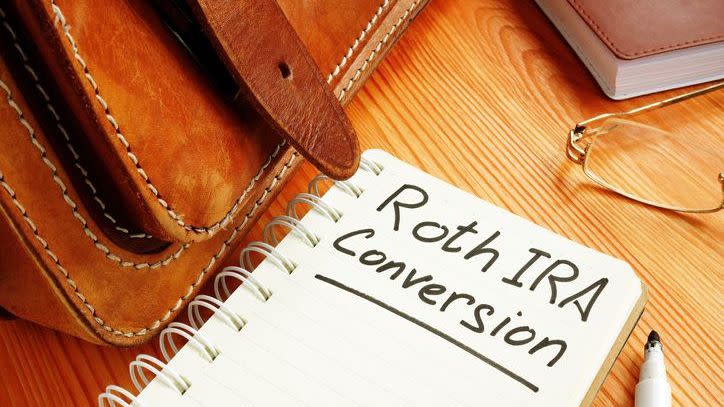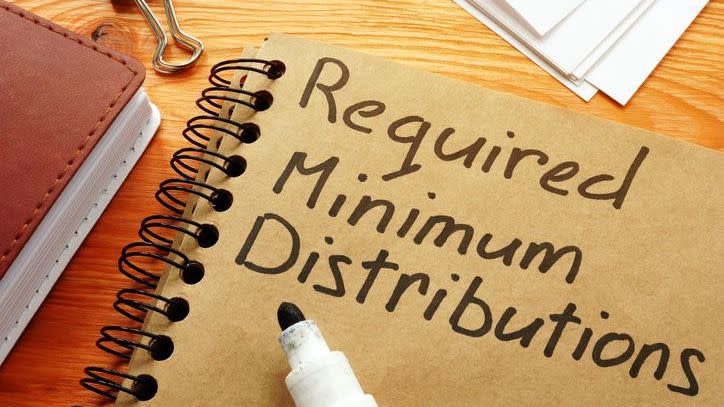
“Do I just have to ‘bite the bullet’ and pay the taxes?”
Source link
RMDs
I’m 60 With $1.2 Million in an IRA. Should I Convert $120,000 Per Year to a Roth to Avoid RMDs?

If you’re 60 years old with $1.2 million saved for retirement in a traditional IRA, you may be starting to think about required minimum distributions (RMDs) and the hefty annual tax bill they can create once you turn 73. Converting a portion of your IRA to a Roth IRA each year can help you reduce or avoid RMDs and take control of your tax bill – but also comes at a cost. Discuss your Roth IRA conversion questions with a financial advisor to determine if this strategy aligns with your broader financial plan.
RMD Rules: The Basics
Once you turn 73, the IRS requires that you start taking annual distributions called required minimum distributions (RMDs) from traditional IRAs, 401(k)s and similar tax-deferred accounts. RMDs are calculated by dividing your account balance by your life expectancy factor, a value that is set by the IRS based on your age.
RMD withdrawals are treated as ordinary income. With a large IRA balance, the size of the mandatory RMDs could easily push someone into a higher tax bracket and result in a higher tax bill. Remember, a financial advisor can be a valuable resource when it comes to planning for RMDs.
Roth Conversions

Roth IRAs, unlike traditional IRAs and 401(k)s, aren’t subject to RMD rules. So by converting your IRA to a Roth, you could avoid having to pay extra income taxes from mandatory IRA withdrawals in retirement. The catch is that you have to pay income taxes on the amount you convert at your ordinary income rate when you convert it. This can lead to a massive tax bill if you were to convert a $1.2 million IRA to a Roth all at once.
Instead, gradually converting your traditional IRA to a Roth IRA allows you to control when you pay taxes. Rather than unspecified mandatory RMD withdrawals, you choose when to take taxable Roth conversions. Roth withdrawals in retirement are then tax-free, provided you wait five years to withdraw those assets.
Keep in mind that the five-year period applies to each conversion. If you were to convert a portion of your IRA in 2024, 2025 and 2026, you’d have to wait until 2029, 2030 and 2031, respectively, to withdraw each group of funds tax-free.
If you need additional help navigating the rules surrounding Roth conversions, use this tool to match with a financial advisor.
A Roth Conversion Example
Assuming your investments grow at 5% each year for 13 years, your $1.2 million IRA could be worth around $2.3 million by the time you reach age 73. By that time, your first RMD would be approximately $87,000 based on the IRS life expectancy factor. Assuming you’re collecting $80,000 annually in taxable income from pensions and Social Security, adding an extra $87,000 would push you from the 22% bracket into the 24% bracket. (This assumes that the current tax brackets remain in place after 2025 when key provisions of the Tax Cut and Jobs Act sunset.)
But with 13 years of $120,000 Roth conversions already completed, the IRA balance requiring RMDs could be reduced to around $42,000 by age 73. Your first RMD would be just under $1,600. This would likely not push you into a higher bracket and save you thousands in annual taxes during retirement compared to taking the full $87,000 distribution without any prior Roth conversions.
The key is to not convert your entire IRA to a Roth immediately, but rather take an incremental approach. By limiting Roth conversions to a certain amount, you can control and potentially reduce your tax liability. Spreading conversions over time allows taxpayers to fill up their current bracket without exceeding it. By staying in lower brackets, more money is shielded from future taxes than paying the IRS immediately at today’s rates.
But you don’t have to do it all alone. A financial advisor can help you plan out your Roth conversion strategy and manage your taxes in retirement.
Roth Conversion Limitations

No matter how you do it, Roth conversions trigger taxes. Without sufficient non-retirement savings or other sources of income, investors may struggle to pay conversion taxes or be forced to sell investments at a loss. Optimal timing and tax planning are also challenging. Tax rates and laws can change frequently, making it hard to predict brackets decades in advance. Income fluctuations from bonuses, dividends or retirement plan withdrawals also complicate projections.
Converting too little defeats the purpose of avoiding higher future RMD taxes. But converting too much could push you into higher brackets now or reduce your flexibility if tax rates decline. Balancing present and future tax minimization is tricky with many uncertainties at play over long time horizons.
Additional factors may also come into play. Deductions that reduce taxable income, state taxes, fluctuating investment returns and income from other sources such as part-time work are all potentially important variables that need to be considered to craft the optimal strategy for Roth conversion. If you need additional help navigating these factors, consider working with a financial advisor.
Bottom Line
Roth IRA conversions let investors take control of the timing of their tax liability. By paying taxes now at known rates through incremental conversions, overall lifetime taxes can be reduced compared to unpredictable mandatory RMD withdrawals decades into the future. But Roth conversions come at a cost today, require non-retirement funds to pay taxes, and involve considerable analysis and some guesswork to optimize.
Retirement Planning Tips
-
A financial advisor can help develop Roth IRA conversion strategies. Finding a financial advisor doesn’t have to be hard. SmartAsset’s free tool matches you with up to three vetted financial advisors who serve your area, and you can have a free introductory call with your advisor matches to decide which one you feel is right for you. If you’re ready to find an advisor who can help you achieve your financial goals, get started now.
-
Knowing how much money you’ll need to retire and whether you’re on track to hit that target is vital when you’re planning for your golden years. SmartAsset’s retirement calculator can help you estimate how much you may have in savings when the time comes for you to retire.
Photo credit: ©iStock.com/monkeybusinessimages, ©iStock.com/designer491, ©iStock.com/designer491
The post I’m 60 With $1.2 Million in an IRA. Should I Convert $120,000 Per Year to a Roth to Avoid RMDs? appeared first on SmartReads by SmartAsset.

If you’re taking a required minimum distribution from an IRA, 401(k) or other tax-deferred account and don’t need the money to cover living expenses, where should you stash that unneeded cash?
Investors now need to start taking RMDs at age 73 or, if they were born after 1960, at age 75. Depending on the balances of your accounts, that distribution can be a sizable amount of money, perhaps more than you need to live on. One option is to reinvest that money, and a Roth IRA would seem to be a perfect choice: withdrawals from Roth accounts are tax-free – including all gains on your investments – and you’ll never need to take any of those pesky RMDs during your lifetime.
There’s just one catch: You can’t directly convert your RMDs to a Roth. But for some people, there is a potential workaround. For 2024, you can contribute up to $7,000 plus another $1,000 if you’re at least 50 years old – if you have enough earned income.
Get matched with a financial advisor to discuss your own retirement strategy.
What is – and isn’t – ‘earned income’
The IRS defines earned income as money you get for working, such as wages, commissions, bonuses, tips and honorariums for speaking, writing or taking part in a conference or convention. Income generated by self-employment also counts. Income that doesn’t qualify includes taxable pension payments, interest income, dividends, rental income, alimony and withdrawals from Roth IRAs or other nontaxable retirement accounts, along with annuities, welfare benefits, unemployment compensation, worker’s compensation payments and your Social Security income.
Another restriction on Roth contributions is the income limit. Once your modified adjusted gross income (MAGI) hits $146,000 for a single filer or $230,000 for joint filers, your maximum Roth contribution starts phasing out up to $161,000 (single filers) or $240,000 (joint filers). After that, you’re no longer eligible to contribute.
You also need to remember that you need to wait five tax years after your first contribution to any Roth account before you can make withdrawals. Heirs who inherit your Roth will need to withdraw the entire balance within 10 years.
Consider speaking with a financial advisor to develop a tax-efficient retirement strategy.
Other options on RMDs
If you don’t qualify to make a Roth contribution, you still have options to eliminate, reduce or delay your RMDs.
Roth conversion: You can convert your IRA to a Roth account, once you’ve taken your RMD for the year. You’ll pay taxes on the amount you convert, so one tactic is to convert the maximum amount available without pushing yourself into a higher tax bracket. Each Roth conversion carries its own five-year rule.
Charitable contribution: You can use a Qualified Charitable Distribution to donate some or all of your RMD to a charity recognized by the IRS and you won’t be taxed on the donated amount. To qualify, the money must be transferred directly from your IRA to the charity.
Keep working: Your 401(k) account with your current employer isn’t subject to RMDs if you’re still on the payroll. One tactic is to roll 401(k)s from previous employers into your current plan so that they won’t be subject to RMDs. Once you stop working, however, RMDs are required.
Be careful: The punishment for failing to take an RMD during the required time period is a hefty one – up to 50% of the missed RMD amount.
A financial advisor can help you navigate the particular risks and tradeoffs in your situation.
Pay attention to all your taxes
Structuring your retirement withdrawals to reduce your tax bite means looking at all your sources of income, including retirement accounts, RMDs, Social Security benefits, pensions and taxable investment income. For some people, withdrawing money from an IRA early in retirement can reduce the size of their eventual RMDs. If they also delay collecting their Social Security benefits, their benefit amount to increase by 8% each year until they reach 70 years old. Also, be sure to coordinate taxes, withdrawals and RMDs between spouses, and remember that a younger spouse’s RMDs won’t need to be taken until they reach age 73 or 75.
Other common retirement tax moves include investing in tax-free bonds, moving to a state with no income tax or estate tax, harvesting tax losses in taxable investment accounts and holding any taxable assets long enough to qualify for lower long-term capital gains tax rates.
To learn more about retirement planning and how to work toward your goals, talk to a financial advisor for free.
Bottom line
How to manage your RMDs – and all the other many tax questions that can arise in retirement – can be complicated. Take the time to estimate your retirement taxes before you start collecting pensions, Social Security and taking withdrawals from retirement accounts.
Tips
-
Balancing taxes and retirement income – and figuring out how to minimize taxes in retirement – is a crucial issue. A knowledgeable financial advisor can help you decide how to structure and coordinate these payments over the span of your retirement.
-
Finding a financial advisor doesn’t have to be hard. SmartAsset’s free tool matches you with up to three vetted financial advisors who serve your area, and you can interview your advisor matches at no cost to decide which one is right for you.
-
Make sure you’re protecting your cash reserves from inflation by securing them in an account that generates a competitive interest rate. Leaving cash in a checking account or low-yield savings account can stifle your purchasing power over time.
Photo credit: ©iStock.com/skynesher
The post Can I Use My RMDs to Transfer Money Into My Roth IRA? appeared first on SmartReads by SmartAsset.
My RMDs Start Soon So I’m Converting $700k to a Roth, But I’m Getting Conflicting Info About Having to Wait Five Years

I’m 68 and recently retired and have about $1.4 million in accounts intended for retirement ($1.2 million in a Traditional IRA and $110K in a Roth). I also am receiving about $47,000 annually in Social Security benefits. My RMDs are scheduled to start in 2027, and as a result, my financial advisor and I are considering doing some annual Roth conversions prior to 2027. It all sounds like a good plan to me, however, I am getting some conflicting information on when I will be able to make withdrawals from the Roth.
My advisor says I will have to wait the standard five years after each Roth conversion deposit before being able to make any withdrawal of those funds (the conversion amount itself and any earnings). However, I have also been told I could withdraw against the conversion amount with no waiting period since I am older than 59 ½. For example, my Roth was established in 2015 and has had a total of $60,000 in contributions and $50,000 in earnings. If I were to do a Roth conversion of $75,000 in 2024 would I then have available $135,000 for withdrawal without any penalty? My advisor says I would only have the original $60,000 available for withdrawal until the five years have passed for the conversion made in 2024. What is the proper withdrawal regulation and rules under those circumstances?
– Jeff
Hey Jeff, great question. This is unfortunately a very confusing topic that is easily jumbled up. It is not surprising that you’ve received or found conflicting information. Fortunately, once you sort through the rules and are able to keep them straight, the answer is very clear.
Because you are over 59 ½ and have had a Roth IRA for five years, you can withdraw any amount of money at any time from any Roth IRA balance you have (conversion or otherwise) without incurring a tax liability or penalty. Period.
Having said that, I am now just another guy that has given you information that conflicts with something else you’ve heard, right? Rather than leaving it at that, let’s walk through the rules and reference the specific information from the IRS. (And if you’re need financial advice or want to find a new advisor to work with, this free tool can help you connect with financial advisors who serve your area.)
What Are the 5-Year Rules?
While Roth IRAs are funded with after-tax money that can be withdrawn tax-free, there are specific rules surrounding how to take this money out of your account.
The IRS has three “five-year rules” for different types of Roth IRAs, but we’ll be discussing two of them here. The first five-year rule specifically applies to accounts that start off as Roth IRAs, while a separate five-year rule solely applies to accounts that are converted into Roth IRAs. Keep in mind that running afoul of either rule can trigger a 10% early withdrawal penalty and/or income taxes on investment earnings. You’ll obviously want to avoid these taxes and penalties as best as you can.
5-Year Rule for Roth IRAs

The first five-year rule dictates that you must wait five years after your initial contribution to a Roth IRA before you can make tax-free withdrawals of any investment earnings. However, the five-year period is retroactive to Jan. 1 of the year in which your first contributions were made.
For example, if you made your first contribution to a Roth IRA in November 2020, the five-year period officially began on Jan. 1, 2020. As a result, you could start withdrawing earnings after Jan. 1, 2025.
But waiting five years alone is only half of the equation. Withdrawals from your Roth IRA must be “qualified” in order for you to avoid taxes and penalties. Luckily, reaching age 59 ½ is the most common way to satisfy this particular requirement.
For instance, funding a Roth IRA at age 45 doesn’t mean someone can make tax- and penalty-free withdrawals from the account five years later. They’ll need to wait until age 59 ½, be disabled or meet one of the other requirements set by the IRS for qualified withdrawals. Likewise, if you open your first Roth IRA when you’re 58, the five years still need to pass before you can withdraw the earnings tax-free. Simply turning 59 ½ isn’t enough in this instance.
Failing to meet both the five-year rule and the rules governing qualified withdrawals may trigger income taxes on the earnings you withdraw, as well as a 10% tax penalty. Jeff, because you opened your Roth IRA in 2015 and you are over 59 ½ years old, you have already satisfied both rules. Plain and simple.
(And if you need help managing your Roth IRA, consider connecting with a financial advisor who serves your area.)
5-Year Rule for Roth Conversions
There is also a separate five-year rule for Roth conversions. If a person is under 59 ½ years old, they must wait five years before they can withdraw any money that’s converted from a traditional IRA into a Roth IRA. And unlike the first five-year rule that only needs to be satisfied once, this rule applies to each individual conversion.
Fortunately, you aren’t subject to early withdrawal penalties by virtue of your age, so this five-year rule also doesn’t apply to you. You’ll automatically avoid the 10% penalty on withdrawals from a converted Roth IRA.
However, here’s the context and rationale for this IRS rule:
Someone who’s under 59 ½ is generally subject to an additional 10% penalty on distributions from IRAs. Without this five-year rule, someone could simply convert a traditional IRA into a Roth IRA (paying the taxes on the conversion, of course) and then immediately withdraw the money from the Roth IRA, thereby sidestepping the 10% early withdrawal penalty. The five-year rule on Roth conversions closes this potential loophole.
Keep in mind that each five-year period starts on Jan. 1 of the year in which the conversion was made. (And if you need help doing a Roth conversion, consider speaking with a financial advisor who can guide you through the process.)
Bottom Line
As they say, age has its privileges. Because you are over 59 ½ and have satisfied the Roth IRA contribution rule, you no longer have to worry about taxes or penalties on any withdrawals you take from your Roth IRA.
Tips for Finding a Financial Advisor
-
Finding a financial advisor doesn’t have to be hard. SmartAsset’s free tool matches you with up to three vetted financial advisors who serve your area, and you can have a free introductory call with your advisor matches to decide which one you feel is right for you. If you’re ready to find an advisor who can help you achieve your financial goals, get started now.
-
If you’re working with a financial advisor but you’re unhappy with the results, you can always consider finding a new professional to work with. Here are some tips for navigating this transition, including how to notify your current advisor about your decision and what you should do before breaking off the professional relationship.
Brandon Renfro, CFP®, is a SmartAsset financial planning columnist and answers reader questions on personal finance and tax topics. Got a question you’d like answered? Email AskAnAdvisor@smartasset.com and your question may be answered in a future column. Questions may be edited for clarity or length.
Please note that Brandon is not a participant on the SmartAsset AMP platform, and he has been compensated for this article. Questions may be edited for clarity or length.
Photo credit: ©iStock.com/Kameleon007
The post Ask an Advisor: My RMDs Start Soon So I’m Converting $700k to a Roth, But I’m Getting Conflicting Info About Having to Wait Five Years appeared first on SmartReads by SmartAsset.
I Was Planning on Taking My RMDs and Converting Them to a Roth, But Was Told I Can’t. Is That True?

If you’re looking for a tax-savvy way to deal with you required minimum distributions (RMDs), converting them into a Roth IRA isn’t an option.
A financial advisor can help you plan for RMDs and figure out if a Roth conversion is right for you.
It’s relatively common for retirees to need a plan for their required minimum distributions. That’s particularly true for households that don’t need their RMDs to cover living expenses and other spending needs. While you can reinvest these withdrawals in taxable accounts, the IRS restricts how you can fund tax-advantaged accounts like a Roth IRA.
Among those restrictions: you can only make IRA contributions with earned income. As a result, you can’t use RMDs to directly fund a Roth IRA.
What Are RMDs?

Starting at age 73 (or 72 depending on your birthdate), the IRS requires you to begin withdrawing a minimum amount each year from your pre-tax retirement accounts, such as 401(k) plans and IRAs. The exact amount depends on your age and the amount in your portfolio. To calculate your RMD, you divide the portfolio’s balance at the end of the year by a published life expectancy factor.
For any given year that you don’t take the full distribution, the IRS will charge you a tax penalty of either 10% or 25% of the amount that’s not withdrawn. For example, say that you don’t withdraw a required $10,000. You could face a tax penalty of up to $2,500.
The IRS requires you to take RMDs from tax-deferred accounts because each withdrawal is a tax event that triggers income taxes. Since you’ve already paid taxes on the money in Roth accounts, the IRS doesn’t require you to take minimum distributions from them. But if you have additional questions surrounding RMDs, consider speaking with a financial advisor.
Can You Invest RMDs in a Roth IRA?
For some retirees, the problem with a required minimum distribution is that they don’t need the money yet. This comes up, particularly for people who alreasdy sufficient income streams or those who hold multiple accounts and want to draw them down one at a time.
While you have several options for how to manage these distributions, you cannot reinvest them in a Roth IRA.
Roth IRA Requirements
You can only make IRA contributions with what’s called “earned income. This is defined as money that you receive from wages, salary, contract income and other forms of work. You cannot make contributions to an IRA – whether its a traditional or Roth account – from investment proceeds, capital gains or many passive income streams like rental properties.
This means that you’re free to get a job in retirement and put that money into a Roth IRA for later in life. However, you cannot withdraw money from a portfolio and transfer it into a Roth IRA or any other form of tax-advantaged retirement account. The IRS discusses this restriction in full in Publication 590-A.
Conversions Are Also Restricted
This subject can get confusing because of the overlap between a withdrawal and a conversion. When you have a pre-tax portfolio, like a 401(k) or an IRA, you are allowed move money directly into a Roth IRA in what’s called a conversion. You take out a lump sum of money from a tax-deferred account, pay income taxes on the amount and deposit it into the Roth IRA.
However, the IRS specifically prohibits you from converting any required distributions into a Roth IRA. You can convert money that isn’t a required distribution, but the law is unambiguous that you cannot do so with an RMD. Navigating the IRS rules for RMDs and Roth conversions can be confusing, which is way you may want to consider connecting with a financial advisor.
Alternative Options for Roth IRAs and Required Minimum Distributions

So, what should you do instead? For retirees, there are a couple of options for how to manage RMDs.
First, you can convert the rest of your pre-tax portfolio after you meet the RMD requirements. In any year with an RMD, the first dollars you withdraw from that account are treated as part of your RMD. Once you meet the minimum amount, you’re free to convert the rest of your account (in whole or in part) into a Roth.
Say you have a $10,000 RMD in a given year. You first must withdraw that $10,000 before you may convert any remaining, eligible amount in your retirement account to a Roth IRA. As always, when doing so remember that Roth earnings have a five-year cooling-off period, so make sure you won’t need this money right away. And if you withdraw any of the money you convert before the five-year period is up, you could owe a 10% penalty on the money (unless you’re age 59 ½ or older).
Second, it is common for retirees to reinvest their minimum distributions. While you can’t put this money back into a tax-advantaged retirement account, you can put it into a taxable investment portfolio. The exact nature of these investments will vary based on your financial strategy and needs. Some retirees may do well investing for growth, taking money that they don’t need and putting it into equity-heavy funds. Others may do well investing for security, taking money that they will need someday and putting it into bond-heavy funds or annuities.
But if you need additional help reinvesting your RMDs, a financial advisor can help you make a plan to put this money to work for you.
Bottom Line
You cannot reinvest required minimum distributions in a Roth IRA. While you can convert any remaining amount from your pre-tax retirement account, the IRS specifically prohibits you from putting RMD funds in a tax-advantaged portfolio. However, RMDs don’t not need to be the end of your investing. You are free to invest this money in a taxable account as you see fit or convert your remaining IRA or 401(k) funds into a Roth account after your RMD for the year has been met.
Tips on Managing Required Minimum Distributions
-
The RMD formula can be difficult to manage, mostly because the IRS’ “life expectancy factor” can seem very arbitrary on the surface. But figuring out what you will need to withdraw is an important piece of long-term retirement planning puzzle.
-
A financial advisor can help you plan for and manage your RMDs. Finding a financial advisor doesn’t have to be hard. SmartAsset’s free tool matches you with up to three vetted financial advisors who serve your area, and you can have a free introductory call with your advisor matches to decide which one you feel is right for you. If you’re ready to find an advisor who can help you achieve your financial goals, get started now.
Photo credit: ©iStock.com/Fly View Productions, ©iStock.com/designer491, ©iStock.com/SDI Productions
The post I Was Planning on Taking My RMDs and Converting Them to a Roth, But Was Told I Can’t. Is That True? appeared first on SmartReads by SmartAsset.
I Have to Take RMDs, But Don’t Need the Money Yet. What Can I Do With It?

While many retirement accounts offer tax-sheltered ways to save and invest, the IRS mandates accountholders start withdrawing money at a certain point. This takes the form of required minimum distributions (RMDs). Required minimum distributions currently start at age 73 for many retirement accounts.
It’s not uncommon to reach an age when the IRS requires you to start withdrawing money from retirement accounts that you don’t need to tap just yet. RMDs can trigger taxes and likely won’t generate a competitive return in your checking account. Instead, here are some ways to think about managing this money.
If you’re looking to build a tax-efficient plan for retirement, talk to a financial advisor today.
Why Plan for RMDs?
Required minimum distributions, or “RMDs,” are withdrawals that the IRS requires you to make from most tax-advantaged retirement accounts. They apply to all pre-tax accounts, such as IRAs and 401(k)s. They do not apply to Roth IRAs and, effective 2024, will no longer apply to Roth 401(k)s.
Starting at age 73, everyone with a qualifying account must take this minimum withdrawal each year. This rule applies per-account, not per-taxpayer. So, say you have both an IRA and a 401(k), then each account will have its own minimum annual withdrawal. The IRS calculates your minimum withdrawals based on your age and the account’s value.
For example, say that you turned 73 this year and have $500,000 in an IRA. The IRS would require you to withdraw at least $18,867 from this IRA by the end of 2023. With a $1 million retirement account, an annual minimum withdrawal of $37,735 would be required.
These are the rules for retirement accounts that you contributed to. Inherited retirement accounts also have required minimum distributions for heirs who receive them. Often you must withdraw this money within 10 years of inheriting it, but the specifics vary widely based on the nature of the account and its original owner.
Remember, a financial advisor can help you determine the best way to structure your withdrawals.
What Can You Do With Your RMDs?
At age 73 you can realistically have decades ahead of you, so don’t just take out this cash and put it into a depository account. A few ways you can make the money work for you include:
In-Kind Transfers Can Save on Taxes
With an in-kind transfer, you move investment assets from one category of portfolio to another. This counts as a withdrawal, so it would satisfy your RMD requirements. But because it’s not a sale, it would not trigger a tax event. An in-kind transfer also leaves your assets invested, so that your money can keep growing according to your original plan.
So, for example, you could transfer an amount of stocks from a 401(k) to a taxed portfolio. As long as the value of your stocks matches your required minimum withdrawal, you will meet the IRS’ requirements without having to liquidate assets or pay taxes.
Redistribute for Safe Growth
Just because you don’t need this money right now doesn’t mean you won’t need it later. In that case, a required minimum withdrawal can be a golden opportunity to transfer your money from growth toward long-term security. Assets like a certificate of deposit (CD) or a Treasury bond can be an excellent way to minimize risk and prevent your money from losing value to inflation.
Redistribute for Growth
“You have to own more equities in retirement than you think,” said Kevin Caldwell, a financial planner with Golden Road Advisors.
The counterpoint to managing risk in retirement is anticipating growth, he said, because longevity should be at the forefront of your retirement conversations. Ideally you have a long life ahead and, while by no means a certainty, extended life and health in the years to come are also not an edge case possibility. You certainly don’t want your 100th birthday to come as an unwelcome surprise.
Years of spending, inflation and costs of living increases, and medical bills will all put demands on your retirement account. Particularly if you don’t need these distributions, that might make this money perfect for growth-oriented investing to help manage those needs.
Talk to a financial advisor about competitive ways to grow your money.
Consider a Qualified Charitable Deduction
Or, said Caldwell, if you are feeling charitable you can skip the minimum distribution altogether in favor of a Qualified Charitable Deduction (QCD).
A Qualified Charitable Deduction is a good way to manage your taxes around RMDs, while doing some good at the same time. Here, instead of withdrawing money from your retirement account you can transfer the cash or assets directly to a charity. The IRS will treat this as an above-the-line deduction, meaning that you won’t pay taxes on the assets you donate and can still claim the standard deduction for that year, and you will have met your RMDs.
Effectively, this allows you to meet your required minimum distribution tax-free.
If you need help structuring your retirement, talk to a financial advisor today.
The Bottom Line
If you need to start taking RMDs, but don’t yet need the money, it’s important to figure out how you want to use this money. You can invest for growth or safety, or you can simply try to manage the taxes that this will trigger.
Managing Your Required Minimum Distribution Tips
-
One thing to remember is that the IRS calculates your required minimum distributions annually. You have all year to take this withdrawal, in a lump sum or in pieces. So… what’s best for your money?
-
A financial advisor can help you build a comprehensive retirement plan. Finding a financial advisor doesn’t have to be hard. SmartAsset’s free tool matches you with up to three vetted financial advisors who serve your area, and you can have a free introductory call with your advisor matches to decide which one you feel is right for you. If you’re ready to find an advisor who can help you achieve your financial goals, get started now.
Photo credit: ©iStock.com/Charday Penn
The post I Have to Take RMDs, But Don’t Need the Money Yet. What Can I Do With It? appeared first on SmartReads by SmartAsset.
I’m 77 and Still Working. Is it True That I Don’t Have to Take RMDs?

I’m 77 years old and I requested my 401(k) fund administrator to prepare my RMD. I was told I do not have to withdraw my money if I am still employed. Please confirm if this in fact an IRS rule or that of the fund management company?
-Bea
That is correct, Bea. If you are still employed, you do not have to take a required minimum distribution (RMD) from your current 401(k) regardless of your age, as long as your employer doesn’t require it. That is in fact an IRS rule.
RMD requirements depend on your age, the account type and whether or not you are still employed. There have been some changes to these rules recently, so let’s review the minimum distribution requirements. (And if you need help with retirement planning, including RMDs, consider speaking with a financial advisor.)
What Are RMDs and When Are They Mandated?

The IRS won’t let you leave your retirement savings in tax-deferred accounts indefinitely. Instead, the government requires you to withdraw a certain amount of money from your accounts each year. How much you’re mandated to withdraw is based on your age and how much money was in your account at the end of the previous year.
Before the SECURE Act of 2019, RMDs started at age 70 ½. However, the law increased the RMD age to 72.
That increase was short-lived, though. The SECURE Act 2.0 raised the RMD age to 73 beginning in 2023 and set it to increase to 75 in 2033.
You are required to take an RMD from most tax-advantaged retirement accounts with the exception of Roth IRAs.
Under prior law, designated Roth accounts within employer-sponsored plans like Roth 401(k)s and Roth 403(b)s were still subject to RMD rules. However, the SECURE Act 2.0 addressed this shortcoming, and beginning in 2024 no Roth accounts will be subject to age-based RMDs. I specify “age-based” here to acknowledge the fact that inherited Roth accounts are still subject to the 10-year rule. (And if you have other retirement-related questions, this tool can help match you with potential financial advisors.)
Are You Still Working?

Here lies the exception that applies to you. If you are still employed then you don’t have to take RMDs from the plan that your current employer sponsors.
However, even if you are still working then you must still take RMDs from:
So, if you have a 401(k) from a former employer, you’ll need to make sure that you’re taking RMDs from that account. A good workaround for avoiding RMDs for an old account is to simply roll those funds over into your current plan if you are allowed. (And if you need help planning your RMDs, consider working with a financial advisor.)
Bottom Line
Since you are still employed, you are not required to take an RMD from your current employer’s retirement plan. RMDs also don’t apply to Roth accounts. However, you still need to take an RMD if you still have a retirement account from a former employer.
Tips for Finding a Financial Advisor
-
Finding a financial advisor doesn’t have to be hard. SmartAsset’s free tool matches you with up to three vetted financial advisors who serve your area, and you can have free introductory calls with your advisor matches to decide which one you feel is right for you. If you’re ready to find an advisor who can help you achieve your financial goals, get started now.
-
Consider a few advisors before settling on one. It’s important to make sure you find someone you trust to manage your money. As you consider your options, these are the questions you should ask an advisor to ensure you make the right choice.
Brandon Renfro, CFP®, is a SmartAsset financial planning columnist and answers reader questions on personal finance and tax topics. Got a question you’d like answered? Email AskAnAdvisor@smartasset.com and your question may be answered in a future column.
Please note that Brandon is not a participant in the SmartAdvisor Match platform, and he has been compensated for this article.
Photo credit: ©iStock.com/LumiNola, ©iStock.com/FG Trade
The post Ask an Advisor: I’m 77 and Still Working. Is it True That I Don’t Have to Take RMDs? appeared first on SmartReads by SmartAsset.






